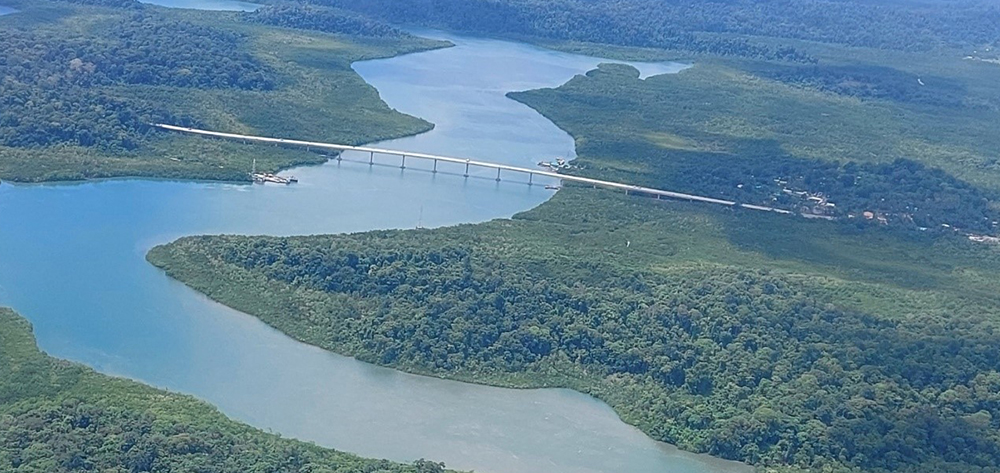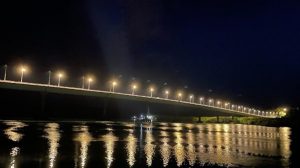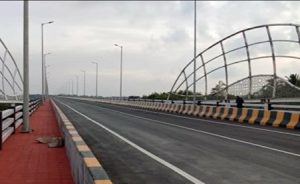- Feedback
- Sitemap
- Skip to Main Content
- Screen Reader Access
- A+ A A -
- A A
- Control Room No. - 9205949400, 011-26768950
Andaman & Nicobar Islands

Andaman & Nicobar Islands
A Bridge to usher in an era of development
Bridges are one of the most critical features of road networks, they connect communities, facilitate easier travel of people, transportation of goods and cargoes, and enhance ease of mobility in tougher topography. The importance of bridges increases when they are built in regions that remain isolated from the mainstream and where the development of infrastructure is negligible.
One such bridge is the 1.45-km-long Humphrey Strait Creek Bridge (HSCB) or “Azad Hind Fauz Setu” in the Andaman & Nicobar Islands. It is the longest bridge in the Eastern Archipelago and is the most crucial part of the Andaman Trunk Road (NH 223). The bridge brings life to NH 223. The bridge connects Gandhi Ghat Jetty on Baratang Island to Uttara Jetty in Middle and North Andaman. Built by the National Highways & Infrastructure Development Corporation (NHIDCL), the bridge has added immense value to the growth of infrastructure in the isolated archipelago in recent years. The design of the bridge is congruous to allow the passage of smaller tonnages underneath it without any obstruction. The Eastern Archipelago is one of India’s most beautiful and serene places but sadly, it is also one of the least explored territories due to various reasons including connectivity.

Bridges are being built elsewhere too in India and their importance is not lost on anyone, but the importance of HSCB in the archipelago is far greater than any other bridge as it adds to the socio-economic value of the entire Andaman Trunk Road. For instance, before the completion of HSCB, the movement of people and cargo between the two parts of the island was completely dependent on the ferry service. But the ferry service was frequently disrupted due to inclement weather conditions in the archipelago limiting the availability of options for mobility in the region. Also, the travel time between Middle Strait and Baratang in Middle Andaman was roughly around two hours but the bridge has now reduced the travel time to just forty-five minutes. The high-quality bridge construction has enabled an increase in vehicular speed further easing the flow of traffic. Earlier, tourist flow to the archipelago was only limited to and around Port Blair as frequent disruptions in ferry service made it difficult for tourists to explore different parts of the island. Travelling to the mud volcano, limestone caves, and Parrot Island in Baratang was earlier much dependent on unreliable ferry service. The problem has been resolved with the completion of the bridge.

On top of these advantages, one must not lose sight of the strategic significance of building high-quality infrastructure in the eastern archipelago that is sturdy, durable, and accessible all year round. It is estimated that at present, around 80% of the world’s oil trade passes through the Malacca Strait, which is about 15 nautical miles from Indira Point in the southernmost tip of the archipelago. Therefore, it is imperative to have such quality infrastructure in place in these strategic locations that can be leveraged during any adverse situation.
NHIDCL has been entrusted by the Union government with the task of creating quality infrastructure in such strategic locations that not only add value to the socio-economic condition of the region but also have ample scope to be used for strategic operations when required. One noticeable feature of the Humphrey Strait Creek Bridge is that though it passes through an ecologically sensitive forest, the bridge has barely affected the sensitive area.
The bridge has now become a lifeline for the local inhabitants of the archipelago, and the local administration and has also increased the flow of trade and tourists into the Andaman & Nicobar Islands. It will also bring down the cost of transportation of cargo as well as lower the travel cost and time for people between the islands.








